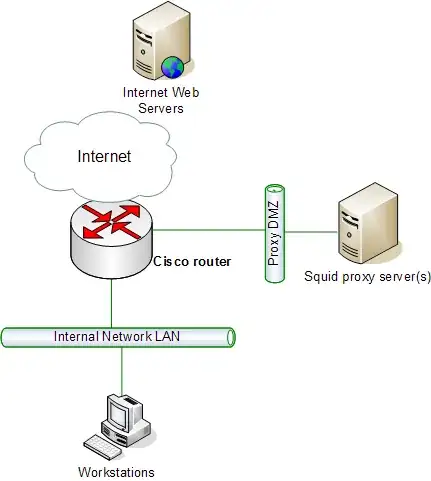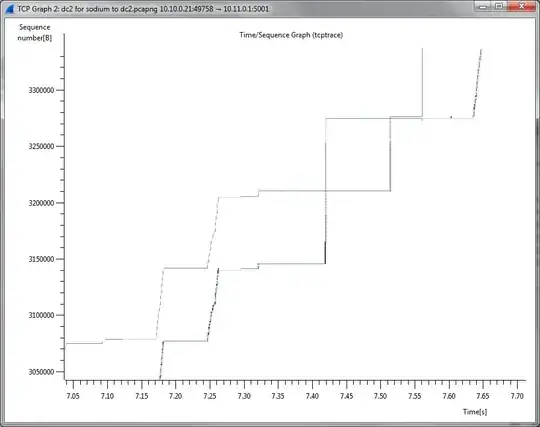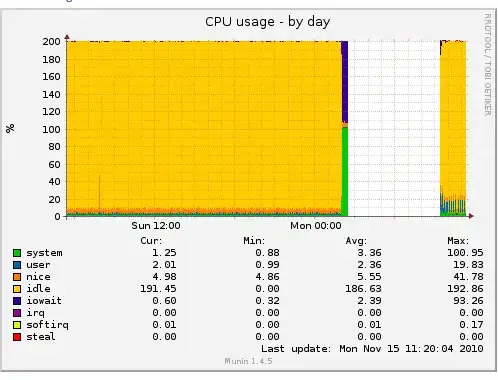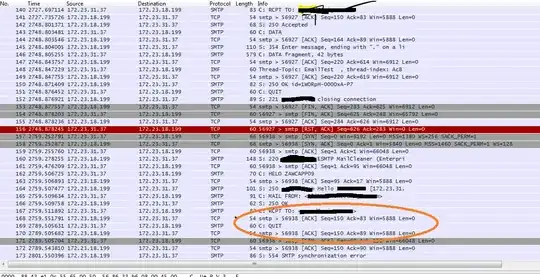Facts (please identify any false statements):
I have a 100 Mbps connection between two sites that are 80 ms apart
This is a long fat connection that could benefit from a large TCP window size perhaps up to 100 Mbps * 0.08 sec = 1,000,000 bytes
Both machines are running Windows Server 2012. "Receive window auto tuning level" is normal on both. "Window scaling heuristics" are disabled on both.
I ran "iperf -s" on one side and "iperf -c" on the other. The transfer happened at 5 Mbps. I get the same result going the other direction.
Both sides advertised support for TCP sliding windows in their SYNs.
The receiver requested a TCP window size of 64,512 bytes (0xFC00) during the entire run with a TCP window scale value of "no shift" (0x000).
The network was able to handle a larger window size (see sequence diagrams below)
The receiver kept the window smaller than the network supports
This connection is happening within an IPSEC VPN. MTU of the tunnel interface is reduced to 1400 bytes in both directions.
Question
- Why is the receiver keeping the window small?
Non-Answers
The network is broken
Linux machines running on the same network open the TCP window to 1.5 megabytes and transmit data at 6 times the bandwidth
Window scaling heuristics are enabled
Window scaling heuristics are disabled (see output of "netsh interface tcp show heuristics" below)
Receive Window Auto-Tuning Level is not normal
Receive Window Auto-Tuning Level is normal (see output of "netsh interface tcp show global" below)
This just doesn't work well on a virtual machine within ESXi
I get 6 times better performance on a virtual linux machine running on the same host.
Update 1 June 12, 2015 4:30 pm PDT
I modified the test by putting linux on one side of the connection. Sure enough, when linux sends data to Windows Server 2012, Windows offers a too-small TCP receive window (64,512 bytes).
When I send data from Windows to linux, linux offers a large-enough TCP receive window (1,365,120 bytes). However, Windows restricts sends to max ~60,000 bytes in flight.
Update 2 June 13, 2015 3:00 pm PDT
A step closer to root cause. In my setup, neither SO_SNDBUF nor SO_RCVBUF are set (by iperf). These are the send and receive buffers which effectively bound the receive window. When not specifying these values, Windows Server 2012 provide a default value of 64 kB. So the question is now:
Question
- When one is not specified, why isn't Windows Server 2012 dynamically increasing SO_SNDBUF/SO_RCVBUF to accommodate long fat pipes as described at MSDN?
Non-answers
"netsh winsock show autotuning" is disabled
It is enabled.
Update 3 August 24, 2015 4:00 pm PDT
netsh apparently has been replaced with Set-NetTCPSetting and family. Get-NetTCPSetting combined with Get-NetTCPConnection shows I am operating in the 'Internet' regime which offers me these settings:
SettingName : Internet
MinRto(ms) : 300
InitialCongestionWindow(MSS) : 4
CongestionProvider : CTCP
CwndRestart : False
DelayedAckTimeout(ms) : 50
MemoryPressureProtection : Enabled
AutoTuningLevelLocal : Normal
AutoTuningLevelGroupPolicy : NotConfigured
AutoTuningLevelEffective : Local
EcnCapability : Enabled
Timestamps : Disabled
InitialRto(ms) : 3000
ScalingHeuristics : Disabled
DynamicPortRangeStartPort : 49152
DynamicPortRangeNumberOfPorts : 16384
Sender TCP Settings
PS C:\Users\acs> netsh interface tcp show global
Querying active state...
TCP Global Parameters
----------------------------------------------
Receive-Side Scaling State : enabled
Chimney Offload State : disabled
NetDMA State : disabled
Direct Cache Access (DCA) : disabled
Receive Window Auto-Tuning Level : normal
Add-On Congestion Control Provider : none
ECN Capability : enabled
RFC 1323 Timestamps : disabled
Initial RTO : 3000
Receive Segment Coalescing State : enabled
PS C:\Users\acs> netsh interface tcp show heuristics
TCP Window Scaling heuristics Parameters
----------------------------------------------
Window Scaling heuristics : disabled
Qualifying Destination Threshold : 3
Profile type unknown : normal
Profile type public : normal
Profile type private : normal
Profile type domain : normal
PS C:\Users\acs> Get-NetTCPSetting
SettingName : Automatic
MinRto(ms) :
InitialCongestionWindow(MSS) :
CongestionProvider :
CwndRestart :
DelayedAckTimeout(ms) :
MemoryPressureProtection :
AutoTuningLevelLocal :
AutoTuningLevelGroupPolicy :
AutoTuningLevelEffective :
EcnCapability :
Timestamps :
InitialRto(ms) :
ScalingHeuristics :
DynamicPortRangeStartPort :
DynamicPortRangeNumberOfPorts :
SettingName : Custom
MinRto(ms) : 20
InitialCongestionWindow(MSS) : 4
CongestionProvider : DCTCP
CwndRestart : True
DelayedAckTimeout(ms) : 10
MemoryPressureProtection : Enabled
AutoTuningLevelLocal : Normal
AutoTuningLevelGroupPolicy : NotConfigured
AutoTuningLevelEffective : Local
EcnCapability : Enabled
Timestamps : Disabled
InitialRto(ms) : 3000
ScalingHeuristics : Disabled
DynamicPortRangeStartPort : 49152
DynamicPortRangeNumberOfPorts : 16384
SettingName : Compat
MinRto(ms) : 300
InitialCongestionWindow(MSS) : 2
CongestionProvider : Default
CwndRestart : False
DelayedAckTimeout(ms) : 200
MemoryPressureProtection : Enabled
AutoTuningLevelLocal : Normal
AutoTuningLevelGroupPolicy : NotConfigured
AutoTuningLevelEffective : Local
EcnCapability : Enabled
Timestamps : Disabled
InitialRto(ms) : 3000
ScalingHeuristics : Disabled
DynamicPortRangeStartPort : 49152
DynamicPortRangeNumberOfPorts : 16384
SettingName : Datacenter
MinRto(ms) : 20
InitialCongestionWindow(MSS) : 4
CongestionProvider : DCTCP
CwndRestart : True
DelayedAckTimeout(ms) : 10
MemoryPressureProtection : Enabled
AutoTuningLevelLocal : Normal
AutoTuningLevelGroupPolicy : NotConfigured
AutoTuningLevelEffective : Local
EcnCapability : Enabled
Timestamps : Disabled
InitialRto(ms) : 3000
ScalingHeuristics : Disabled
DynamicPortRangeStartPort : 49152
DynamicPortRangeNumberOfPorts : 16384
SettingName : Internet
MinRto(ms) : 300
InitialCongestionWindow(MSS) : 4
CongestionProvider : CTCP
CwndRestart : False
DelayedAckTimeout(ms) : 50
MemoryPressureProtection : Enabled
AutoTuningLevelLocal : Normal
AutoTuningLevelGroupPolicy : NotConfigured
AutoTuningLevelEffective : Local
EcnCapability : Enabled
Timestamps : Disabled
InitialRto(ms) : 3000
ScalingHeuristics : Disabled
DynamicPortRangeStartPort : 49152
DynamicPortRangeNumberOfPorts : 16384
Sender SYN
No. Time Source Destination Protocol Length Delta Sequence number Acknowledgment number Bytes in flight Calculated window size Info
814 5.036577000 10.10.0.21 10.11.0.1 TCP 66 0.000000000 0 0 64512 49758→5001 [SYN, ECN, CWR] Seq=0 Win=64512 Len=0 MSS=1460 WS=1 SACK_PERM=1
Frame 814: 66 bytes on wire (528 bits), 66 bytes captured (528 bits) on interface 0
Ethernet II, Src: 00:11:22:33:44:55, Dst: aa:bb:cc:dd:ee:ff
Internet Protocol Version 4, Src: 10.10.0.21 (10.10.0.21), Dst: 10.11.0.1 (10.11.0.1)
Transmission Control Protocol, Src Port: 49758 (49758), Dst Port: 5001 (5001), Seq: 0, Len: 0
Source Port: 49758 (49758)
Destination Port: 5001 (5001)
[Stream index: 73]
[TCP Segment Len: 0]
Sequence number: 0 (relative sequence number)
Acknowledgment number: 0
Header Length: 32 bytes
.... 0000 1100 0010 = Flags: 0x0c2 (SYN, ECN, CWR)
Window size value: 64512
[Calculated window size: 64512]
Checksum: 0x1451 [validation disabled]
Urgent pointer: 0
Options: (12 bytes), Maximum segment size, No-Operation (NOP), Window scale, No-Operation (NOP), No-Operation (NOP), SACK permitted
Maximum segment size: 1460 bytes
No-Operation (NOP)
Window scale: 0 (multiply by 1)
Kind: Window Scale (3)
Length: 3
Shift count: 0
[Multiplier: 1]
No-Operation (NOP)
No-Operation (NOP)
TCP SACK Permitted Option: True
Sender perspective of sequence graph

Receiver TCP Settings
PS C:\Users\acs> netsh interface tcp show global
Querying active state...
TCP Global Parameters
----------------------------------------------
Receive-Side Scaling State : enabled
Chimney Offload State : disabled
NetDMA State : disabled
Direct Cache Access (DCA) : disabled
Receive Window Auto-Tuning Level : normal
Add-On Congestion Control Provider : none
ECN Capability : enabled
RFC 1323 Timestamps : disabled
Initial RTO : 3000
Receive Segment Coalescing State : enabled
PS C:\Users\acs> netsh interface tcp show heuristics
TCP Window Scaling heuristics Parameters
----------------------------------------------
Window Scaling heuristics : disabled
Qualifying Destination Threshold : 3
Profile type unknown : normal
Profile type public : normal
Profile type private : normal
Profile type domain : normal
PS C:\Users\acs> Get-NetTCPSetting
SettingName : Automatic
MinRto(ms) :
InitialCongestionWindow(MSS) :
CongestionProvider :
CwndRestart :
DelayedAckTimeout(ms) :
MemoryPressureProtection :
AutoTuningLevelLocal :
AutoTuningLevelGroupPolicy :
AutoTuningLevelEffective :
EcnCapability :
Timestamps :
InitialRto(ms) :
ScalingHeuristics :
DynamicPortRangeStartPort :
DynamicPortRangeNumberOfPorts :
SettingName : Custom
MinRto(ms) : 20
InitialCongestionWindow(MSS) : 4
CongestionProvider : DCTCP
CwndRestart : True
DelayedAckTimeout(ms) : 10
MemoryPressureProtection : Enabled
AutoTuningLevelLocal : Normal
AutoTuningLevelGroupPolicy : NotConfigured
AutoTuningLevelEffective : Local
EcnCapability : Enabled
Timestamps : Disabled
InitialRto(ms) : 3000
ScalingHeuristics : Disabled
DynamicPortRangeStartPort : 49152
DynamicPortRangeNumberOfPorts : 16384
SettingName : Compat
MinRto(ms) : 300
InitialCongestionWindow(MSS) : 2
CongestionProvider : Default
CwndRestart : False
DelayedAckTimeout(ms) : 200
MemoryPressureProtection : Enabled
AutoTuningLevelLocal : Normal
AutoTuningLevelGroupPolicy : NotConfigured
AutoTuningLevelEffective : Local
EcnCapability : Enabled
Timestamps : Disabled
InitialRto(ms) : 3000
ScalingHeuristics : Disabled
DynamicPortRangeStartPort : 49152
DynamicPortRangeNumberOfPorts : 16384
SettingName : Datacenter
MinRto(ms) : 20
InitialCongestionWindow(MSS) : 4
CongestionProvider : DCTCP
CwndRestart : True
DelayedAckTimeout(ms) : 10
MemoryPressureProtection : Enabled
AutoTuningLevelLocal : Normal
AutoTuningLevelGroupPolicy : NotConfigured
AutoTuningLevelEffective : Local
EcnCapability : Enabled
Timestamps : Disabled
InitialRto(ms) : 3000
ScalingHeuristics : Disabled
DynamicPortRangeStartPort : 49152
DynamicPortRangeNumberOfPorts : 16384
SettingName : Internet
MinRto(ms) : 300
InitialCongestionWindow(MSS) : 4
CongestionProvider : CTCP
CwndRestart : False
DelayedAckTimeout(ms) : 50
MemoryPressureProtection : Enabled
AutoTuningLevelLocal : Normal
AutoTuningLevelGroupPolicy : NotConfigured
AutoTuningLevelEffective : Local
EcnCapability : Enabled
Timestamps : Disabled
InitialRto(ms) : 3000
ScalingHeuristics : Disabled
DynamicPortRangeStartPort : 49152
DynamicPortRangeNumberOfPorts : 16384
Receiver SYN
No. Time Source Destination Protocol Length Delta Sequence number Acknowledgment number Bytes in flight Calculated window size Info
817 5.110501000 10.11.0.1 10.10.0.21 TCP 70 0.073924000 0 1 64512 5001→49758 [SYN, ACK, ECN] Seq=0 Ack=1 Win=64512 Len=0 MSS=1460 WS=1 SACK_PERM=1 [ETHERNET FRAME CHECK SEQUENCE INCORRECT]
Frame 817: 70 bytes on wire (560 bits), 70 bytes captured (560 bits) on interface 0
Ethernet II, Src: aa:bb:cc:dd:ee:ff, Dst: 00:11:22:33:44:55
Internet Protocol Version 4, Src: 10.11.0.1 (10.11.0.1), Dst: 10.10.0.21 (10.10.0.21)
Transmission Control Protocol, Src Port: 5001 (5001), Dst Port: 49758 (49758), Seq: 0, Ack: 1, Len: 0
Source Port: 5001 (5001)
Destination Port: 49758 (49758)
[Stream index: 73]
[TCP Segment Len: 0]
Sequence number: 0 (relative sequence number)
Acknowledgment number: 1 (relative ack number)
Header Length: 32 bytes
.... 0000 0101 0010 = Flags: 0x052 (SYN, ACK, ECN)
Window size value: 64512
[Calculated window size: 64512]
Checksum: 0xb5bb [validation disabled]
Urgent pointer: 0
Options: (12 bytes), Maximum segment size, No-Operation (NOP), Window scale, No-Operation (NOP), No-Operation (NOP), SACK permitted
Maximum segment size: 1460 bytes
No-Operation (NOP)
Window scale: 0 (multiply by 1)
Kind: Window Scale (3)
Length: 3
Shift count: 0
[Multiplier: 1]
No-Operation (NOP)
No-Operation (NOP)
TCP SACK Permitted Option: True
[SEQ/ACK analysis]
Receiver perspective of sequence graph


TCP Window

